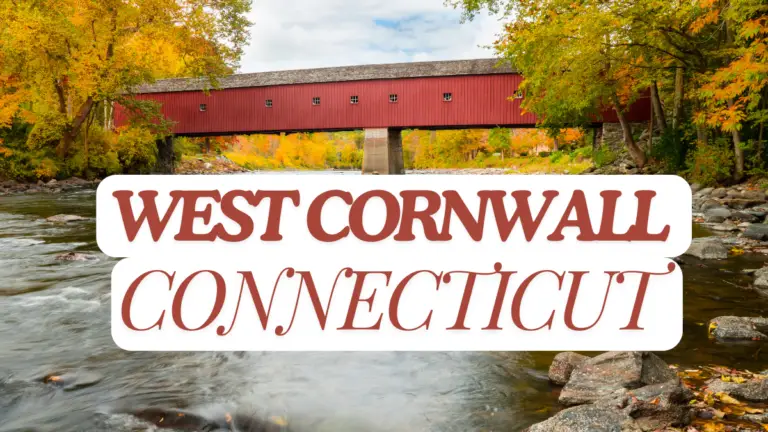Rediscovering Connecticut: A Journey Through New England’s Hidden Gem – See the Top 3
Sometimes the most extraordinary discoveries happen closest to home. As a seasoned traveler who has wandered through dozens of countries and countless states, I found myself genuinely surprised by Connecticut. This compact state, often hurried through on the way to Boston or bypassed entirely…
Sometimes the most extraordinary discoveries happen closest to home. As a seasoned traveler who has wandered through dozens of countries and countless states, I found myself genuinely surprised by Connecticut. This compact state, often hurried through on the way to Boston or bypassed entirely for Vermont’s mountains or Maine’s coast, revealed itself to be a treasure trove of experiences that rivals any New England destination.
The Revelation
Rediscovering Connecticut this Year
My relationship with Connecticut began like most people’s: as a blur of highway signs glimpsed from Interstate 95. For years, I knew it primarily as the stretch between New York and Boston, punctuated by expensive gas stations and the occasional traffic jam. How wrong I was.
The awakening came during an unplanned detour off the beaten path. What started as a simple overnight stop in Essex turned into a week-long exploration that fundamentally changed how I view this often-overlooked state. Connecticut, I discovered, is New England distilled into its purest form. Here, you’ll find the region’s maritime heritage, colonial history, natural beauty, and cultural sophistication compressed into a manageable package that rewards slow, deliberate exploration.
Coastal Connecticut: Maritime Magic Along Long Island Sound
The Connecticut coast stretches for roughly 100 miles along Long Island Sound, and every mile tells a story. Unlike the rocky, dramatic shores of Maine, Connecticut’s coastline offers gentle harbors, historic seaports, and a maritime culture that feels both authentic and accessible.
Related: Additional Gems to Visit in New England
Mystic stands as the crown jewel of coastal Connecticut. The Mystic Seaport Museum isn’t just a collection of old boats; it’s a living, breathing recreation of 19th-century maritime life. Walking through the recreated village, watching craftspeople work with traditional tools, and boarding historic vessels like the Charles W. Morgan whaling ship provides an immersive experience that brings history to life. The nearby Mystic Aquarium adds a modern complement to the historical focus, featuring beluga whales and innovative marine conservation exhibits.
But Mystic represents just the beginning of coastal Connecticut’s charms. Essex, consistently ranked among America’s best small towns, exemplifies New England elegance without pretension. The town’s Main Street, lined with Federal and Victorian architecture, leads down to the Connecticut River, where the Essex Steam Train offers scenic journeys through the Connecticut River Valley. The combination of riverboat rides and vintage railway cars creates an experience that feels both nostalgic and timeless.
Guilford offers perhaps the most authentic glimpse of colonial Connecticut. The town green, established in 1639, remains virtually unchanged, surrounded by historic homes that now house antique shops, galleries, and restaurants. The Henry Whitfield State Museum, dating to 1639, claims to be the oldest house in Connecticut and provides fascinating insights into early colonial life.
Don’t overlook the smaller coastal communities. Madison boasts Hammonasset Beach State Park, Connecticut’s largest shoreline park, offering two miles of sandy beach and excellent bird watching. Stonington borough, with its narrow streets and historic lighthouse, feels like a maritime village frozen in time.
Autumn’s Spectacular Theater
While Vermont and New Hampshire often claim the fall foliage crown, Connecticut’s autumn display deserves equal recognition. The state’s diverse geography creates varied and spectacular color shows that often extend later into the season than northern New England.
The Litchfield Hills region in northwestern Connecticut provides the most dramatic autumn scenery. Towns like Kent, New Milford, and Washington become painting-perfect during peak foliage, typically from late September through mid-October. Kent Falls State Park offers a stunning 250-foot cascading waterfall surrounded by maples, oaks, and birches in full autumn glory.
Route 7, running north-south through western Connecticut, creates one of New England’s most underrated scenic drives. The road winds through rolling hills, past antique barns, stone walls, and picture-perfect New England towns. Unlike the crowded scenic routes in Vermont, Connecticut’s back roads often provide solitary communion with autumn’s beauty.
For photographers, Gillette Castle State Park in East Haddam offers elevated views over the Connecticut River Valley, with layers of colored hills extending into the distance. The castle itself, built by actor William Gillette in the early 1900s, adds an unexpected architectural element to landscape photographs.
Historic Treasures and Living Museums
Connecticut’s role in American history extends far beyond its colonial origins. The state’s central location and early industrialization created a rich tapestry of historical sites that span from the 1600s through the industrial age.
Hartford, the state capital, houses the Mark Twain House and Museum, where Samuel Clemens wrote his most famous works including “The Adventures of Tom Sawyer” and “Adventures of Huckleberry Finn.” The Victorian Gothic mansion reflects Twain’s success and provides insights into Gilded Age American life. Nearby, the Harriet Beecher Stowe Center celebrates the author of “Uncle Tom’s Cabin” and her role in the abolition movement.
New Haven offers architectural and cultural treasures anchored by Yale University. The campus itself functions as an outdoor museum of collegiate Gothic architecture, while the Yale University Art Gallery and Peabody Museum of Natural History provide world-class collections. Beyond the university, New Haven’s historic districts showcase Federal, Greek Revival, and Victorian architecture in remarkable concentration.
The quirky Gillette Castle deserves special mention. William Gillette, who became famous playing Sherlock Holmes on stage, built this medieval-inspired stone castle overlooking the Connecticut River. The 24-room mansion features secret doors, built-in couches, and Gillette’s model railroad that once carried guests around the property.
For aviation enthusiasts, the New England Air Museum in Windsor Locks houses one of the largest collections of aircraft and aviation artifacts in the Northeast, including a rare Sikorsky VS-44A flying boat.
A Culinary Renaissance
Connecticut’s food scene has evolved dramatically over the past decade, combining traditional New England fare with farm-to-table innovation and international influences.
New Haven pizza, known locally as “apizza” (pronounced “ah-beetz”), represents Connecticut’s most famous culinary export. Frank Pepe Pizzeria Napoletana, Sally’s Apizza, and Modern Apizza create thin-crust, coal-fired pizzas that differ significantly from New York or Chicago styles. The white clam pizza at Pepe’s, topped with fresh littlenecks, olive oil, garlic, and cheese, has achieved legendary status among food enthusiasts.
Beyond pizza, Connecticut’s restaurant scene reflects the state’s agricultural richness. The Litchfield Hills region supports numerous farm-to-table restaurants that showcase local ingredients. The Hopkins Inn in New Preston, overlooking Lake Waramaug, combines Austrian-influenced cuisine with Connecticut-grown produce and spectacular lake views.
Connecticut’s craft beverage scene has exploded in recent years. Two Roads Brewing Company in Stratford and Thimble Islands Brewing in Branford represent the state’s growing craft beer movement. Connecticut also produces wine, with vineyards like Chamard Vineyards in Clinton creating respectable vintages from cold-climate grapes.
Farmers markets throughout the state offer seasonal specialties: spring asparagus, summer sweet corn, autumn apples, and winter root vegetables. The West Hartford Farmers Market and New Milford Farmers Market rank among the state’s best, featuring not just produce but artisanal cheeses, baked goods, and prepared foods.
Natural Escapes and Outdoor Adventures
Despite its small size and high population density, Connecticut offers surprising opportunities for outdoor recreation and natural beauty.
Sleeping Giant State Park in Hamden provides excellent hiking with rewarding summit views. The park’s trail system accommodates various skill levels, from easy nature walks to challenging climbs up the “giant’s” head. The summit tower offers panoramic views extending to Long Island Sound on clear days.
Devil’s Hopyard State Park in East Haddam features Chapman Falls, a 60-foot waterfall that cascades over a series of stone steps. The park’s unusual name derives from local legends about the devil’s involvement in creating the circular potholes near the falls. The hiking trails explore diverse ecosystems, from hemlock ravines to oak-hickory forests.
Talcott Mountain State Park in Simsbury offers the Heublein Tower, a Bavarian-style observation tower that provides spectacular views of the Connecticut River Valley and, on clear days, the Hartford skyline. The relatively easy hike to the tower makes this accessible for families.
Connecticut’s location provides four distinct seasons of outdoor activities. Spring brings wildflowers and migrating birds. Summer offers swimming, boating, and hiking in comfortable temperatures. Autumn combines perfect hiking weather with spectacular foliage. Winter transforms the state into a wonderland for cross-country skiing and snowshoeing.
Cultural Sophistication in Unexpected Places
Connecticut’s cultural offerings extend far beyond what you’d expect from a small state. Hartford‘s Wadsworth Atheneum, founded in 1842, claims to be America’s oldest continuously operating public art museum. The collection spans 5,000 years and includes important works by Caravaggio, Monet, and Picasso.
The Goodspeed Opera House in East Haddam, a Victorian “wedding cake” theater on the Connecticut River, has launched more Broadway musicals than any other theater in America. Shows like “Annie,” “Man of La Mancha,” and “Shenandoah” premiered here before moving to Broadway.
Smaller towns throughout Connecticut support vibrant arts communities. Chester, Essex, and Old Lyme host numerous galleries featuring regional artists. The Florence Griswold Museum in Old Lyme celebrates American Impressionism and the artists who lived and worked along the Connecticut coast.
Connecticut’s festival calendar spans the entire year. The Connecticut Wine Festival, Oyster Festival, and numerous town fairs celebrate local culture and traditions. Summer brings outdoor concerts and theater festivals to venues throughout the state.
Practical Considerations for Connecticut Travel
Timing Your Visit: Connecticut rewards visitors in every season, but timing affects what you’ll experience. Late September through mid-October offers peak foliage with comfortable temperatures. Summer provides warm weather for coastal activities but brings crowds to popular destinations. Spring offers mild temperatures and fewer tourists but variable weather. Winter can be magical with snow-covered landscapes, though some attractions operate on reduced schedules.
Transportation: Connecticut’s compact size makes driving the preferred transportation method. Most attractions lie within two hours of each other. Interstate 95 runs along the coast, while Interstate 84 crosses the state east-west through Hartford. Route 9 provides scenic north-south access through the Connecticut River Valley. Metro-North Railroad connects southwestern Connecticut to New York City, making the state accessible for car-free visitors exploring that region.
Accommodation Options: Connecticut offers lodging for every budget and style. Historic inns like the Copper Beech Inn in Ivoryton and the Mayflower Grace in Washington provide luxury experiences in historic settings. State parks offer camping for budget-conscious travelers. Chain hotels cluster near major highways and cities, while bed-and-breakfasts throughout the state provide intimate, local experiences.
Budget Planning: Connecticut can be expensive, particularly in Fairfield County near New York City. However, many of the state’s best experiences cost little or nothing: state park hiking, town green strolls, and scenic drives. State parks charge modest entrance fees. Many museums offer free or discounted admission on certain days.
The Bottom Line
After spending way more time in Connecticut than I ever planned, here’s what I figured out: this state doesn’t try to be something it’s not. It’s not going to blow you away with the world’s biggest waterfall or most exotic wildlife. What it does is give you authentic New England without the crowds and tourist traps.
You can experience real maritime culture in Mystic without fighting for parking. You can eat incredible farm-to-table food without paying Manhattan prices. You can hike through actual wilderness even though you’re surrounded by suburbs. That’s pretty rare these days.
Connecticut works because it rewards people who take their time and dig a little deeper. Sure, if you just blast through on I-95, you’ll miss everything good. But if you get off the highway, explore the small towns, hit up the state parks, and try the local food, you’ll find a state that’s got everything great about New England packed into a manageable size.
Maybe the best thing about Connecticut is that it proves you don’t need to fly across the country to find something worth exploring. Sometimes the best trips happen when you finally stop driving past places and start exploring what’s been there all along. Connecticut’s been quietly doing its thing this whole time, waiting for people to notice. I’m glad I finally did.
rediscovering Connecticut rediscovering Connecticut rediscovering Connecticut rediscovering Connecticut rediscovering Connecticut rediscovering Connecticut rediscovering Connecticut rediscovering Connecticut rediscovering Connecticut rediscovering Connecticut rediscovering Connecticut rediscovering Connecticut
rediscovering Connecticut rediscovering Connecticut rediscovering Connecticut rediscovering Connecticut rediscovering Connecticut rediscovering Connecticut rediscovering Connecticut rediscovering Connecticut rediscovering Connecticut rediscovering Connecticut rediscovering Connecticut rediscovering Connecticut






